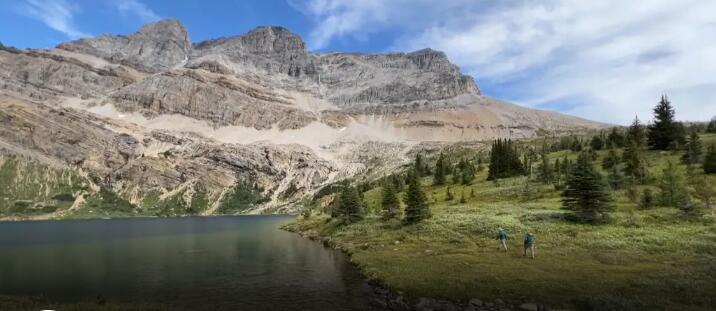After 50 years, westslope cutthroat trout return to lake in Banff National Park

Restoring Hidden Lake is a feat of conservation that Parks Canada worked on for more than a decade
For the first time in 50 years, westslope cutthroat trout are swimming in Hidden Lake again — a feat of conservation that Parks Canada experts have worked on for more than a decade to achieve.
Nestled high up in the Skoki Valley of Banff National park, specialists laboured through trial and error to restore habitat ideal for Alberta’s native, and at-risk, westslope cutthroat trout. This summer, thousands of fishlings strong enough to survive in the wild are swimming free in the lake again.
“I just can’t even believe that we’re finally putting westslope cutthroat trout back in, it’s like the pinnacle of our work,” said biologist Megan Goudie. “A day I thought that we might never see, but here we are.”
Fertilized eggs are transferred from the hatchery to remote stream-side incubators that protect them from becoming prey. The buckets cradle the growing trout and simulate a nest environment as water flows through tubes and a valve set up just so in a moving stream.

For those hiking by it looks like nothing more than an assortment of pipes you might find at Home Depot. But for those working on the project, they signify years of work finally paying off.
If all goes well, in five years this population of tiny fishlings will mature enough to reproduce.
“They were self-sustaining in this lake in the ’50s,” said aquatic specialist Shelley Humphries. “So we fully expect that they’re going to be just fine in this lake going forward.”

Trouble started in the 1900s, when officials introduced non-native species to many lakes in the National Park to stock them for anglers seeking out an exciting catch. The park stopped the practice decades ago, but the damage was done.
Brook and rainbow trout flourished, and choked out the native species. Then, increasing water temperatures made it more difficult for the fish to survive.
Across the park, they now occupy less than 10 per cent of their historical range.

- Parks Canada offers a guided hike of hidden lake for those looking to learn more about the trout
“These feed ospreys and bears,” Humphries said. “The brook trout don’t to the same extent because of the timing of when they spawn and when the bears and the birds are here. We’re fixing a mistake that we made about 50 years ago at this location.”
To fix that mistake, Parks had to accomplish several uphill battles:
- The fish need cool lakes to thrive.
- Because of years of breeding with introduced populations, they needed to find genetically pure trout.
- The introduced species, namely the non-native brook trout, needed to be removed from Hidden Lake.
When the province first listed cutthroat trout as at-risk, Humphries said they embarked on a spawning survey to find where these fish were nesting.
Then, a chance discovery helped establish Hidden Lake as an ideal habitat for this conservation project. They found a waterfall downstream.

“It’s not on our maps and you can’t see it from the aerial photos,” Humphries said.
“We’re so happy that there’s that waterfall down in the valley. It’s going to stop trout from getting back up here and undoing this conservation project that we’ve done.”
With nearby glaciers to keep it cool, and protected by that downstream waterfall, Hidden Lake became the refuge the team was looking for.
Then they got to work, first trying to remove non-native species manually by netting, angling and electrofishing. But that proved frustrating and ultimately unsuccessful.

“After about four years, we realised that actually, it wasn’t working,” Humphries said. “We were still getting a lot of reproduction of the introduced brook trout, so we had to change methods.”
That’s when they decided to go a new route and introduce rotenone, a natural fish toxicant derived from plant roots.
Humphries explained that the pink powder is added to the water, and enters the fish’s system through the gills, inhibiting its breathing on a molecular level. It’s only toxic to fish and isn’t dangerous to people, mammals, or birds at the levels being used.
“It breaks down all by itself rapidly in the sun and with the turbulent water as it’s flowing out of here, it’s breaking down.”
It was way more efficient, she said.
After two years, this treatment offered Parks a blank slate — a lake free from any fish at all and ready to re-introduce the westslope cutthroat trout.
That, Humphries added, kicked off a whole new process: finding the most resilient fish with the best chance of survival.
“They’re threatened. There’s not that many of them, and we can’t go buy them from someplace. We needed to find them on the landscape,” Humphries said.
After training from a hatchery, and rearing the eggs in a mobile incubator, the eggs are sturdy enough to live in the stream.
And those are the alevin — newly spawned trout still carrying the yolks — swimming in the bucket contraptions, being checked on by Parks caretakers until they are ready for release.
Related News
Trump signs executive order to speed up deepsea mining permits
U.S. President Donald Trump on Thursday signed an executive order aimed at boosting the deepseaRead more
See the Ukraine war ceasefire proposals put forth by the Trump administration
Reuters has seen the text of a set of proposals to end Russia’s war inRead more
